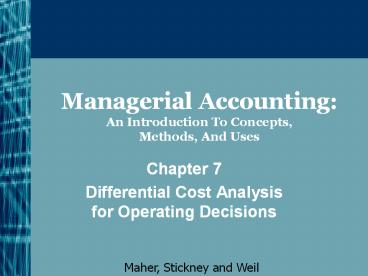Managerial Accounting: An Introduction To Concepts, Methods, And Uses - PowerPoint PPT Presentation
Title:
Managerial Accounting: An Introduction To Concepts, Methods, And Uses
Description:
Explain the theory of constraints. ... Managerial Accounting: An Introduction To Concepts, Methods, And Uses Author: USC Faculty Last modified by: Thomson Learning – PowerPoint PPT presentation
Number of Views:310
Avg rating:3.0/5.0
Title: Managerial Accounting: An Introduction To Concepts, Methods, And Uses
1
Managerial Accounting An Introduction To
Concepts, Methods, And Uses
- Chapter 7
- Differential Cost Analysis
- for Operating Decisions
Maher, Stickney and Weil
2
Learning Objectives (Slide 1 of 3)
- Explain the differential principle know how to
identify costs for differential analysis. - Explain the relation between costs prices.
- Explain how to base target costs on target
prices. - Describe how to use differential analysis to
measure customer profitability.
3
Learning Objectives (Slide 2 of 3)
- Explain why businesses apply differential
analysis to product choice decisions. - Explain the theory of constraints.
- Identify the factors underlying make-or- buy
decisions. - Explain how to identify the costs of producing
joint products the relevant costs for decisions
to sell or process further.
4
Learning Objectives (Slide 3 of 3)
- Explain the use of differential analysis to
determine when to add or drop parts of operations - Identify the factors of inventory management
decisions. - Explain how linear programming optimizes the use
of scare resources (Appendix 8.1) - Identify the use of the economic order quantity
model (Appendix 8.2)
5
Describe Define Differential Analysis
6
Differential Analysis Model
Alternative - Status Quo Difference
Revenue Revenue Revenue Change in Revenue
Less Variable Costs (VC) VC - VC Change in VC
Total Contribution Margin (CM) CM CM Change in CM
Less Fixed Costs Fixed Costs - Fixed Costs Change in Fixed Costs
Operating Profit Profit - Profit Change in Profit
7
Differential Analysis Cont.
- A cost (or revenue) is relevant only if it
differs between alternatives under consideration - Focus is typically on cash flows because
- Cash is the medium of exchange
- Cash is a common, objective measure of benefits
and costs of alternatives
8
What are the three major influences on pricing?
9
Review Short-Run vs. Long-Run Pricing Decisions
- Time horizon of a decision is important in
determining relevant costs in a pricing decision - Short-run decisions include pricing for a
one-time special order - Long-run decisions include pricing a main product
in a major market
10
What is the differential approach to pricing?
11
Long-Run Pricing Decisions (Slide 1 of 3)
- Define Full cost
12
Review the Value Chain
13
Long-Run Pricing Decisions (Slide 3 of 3)
- Full cost approach is justified in pricing
decisions when - Entering into long-term contracts to supply a
product - Developing and producing a customized product
- Initially setting prices, then adjusting for
market conditions
14
Review Life-Cycle Product Costing and Pricing
15
Explain Using Target Prices to Set Target Costs
16
Explain Legal Issues Relating Costs to Prices
17
Customer Profitability
- Differential analysis is useful in determining
which customers to keep or drop - Dropping a customer should result in cost savings
in excess of lost revenue - Alternative uses of extra capacity available
after dropping a customer should be included in
the analysis
18
What are the four general categories of customer
costs?
- Customer costs generally consist of the following
4 categories of activities - ABC provides a better understanding of the cost
of these activities
19
Build a Chart of Activities to Compute Customer
Costs
20
Comment on Decisions when Scarce Resources are
Limited
21
Decisions with Scarce Resources
22
Define the Following
- Theory of Constraints
- Bottleneck
- Throughput Contribution
23
List the Five Steps to Managing Bottlenecks
24
Name Three Options to Relieve a Bottleneck
25
Explain Make or Buy Decisions
26
Define the Following
- Split-Off Point
- Joint Costs
- Additional Processing Costs
27
How do you decide whether to process further or
not?
28
- If you have any comments or suggestions
concerning this PowerPoint Presentation for
Managerial Accounting, An Introduction To
Concepts, Methods, And Uses, please contact - Dr. Michael Blue, CFE, CPA, CMA
- blue_at_bloomu.edu
- Bloomsburg University of Pennsylvania

